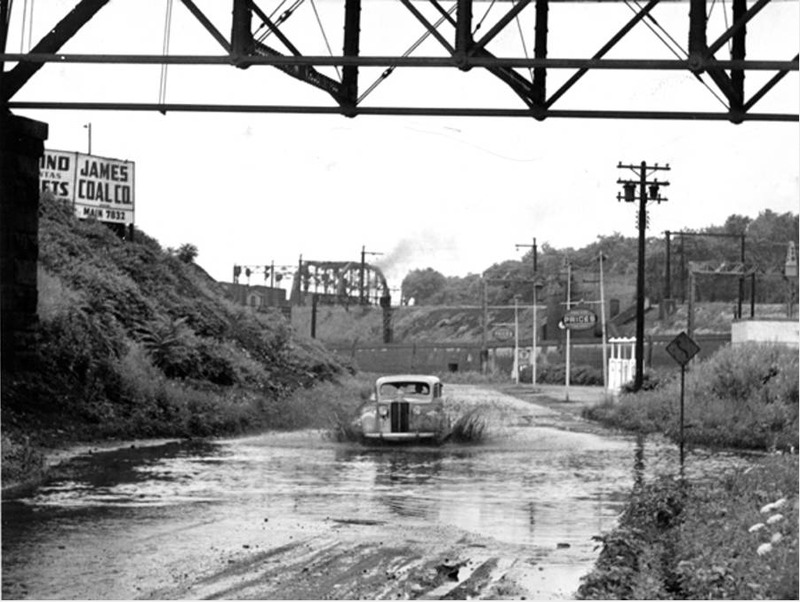Where in the World is Walworth Run?
Bridged, Culverted, Sewered and Today Largely Forgotten

For a long time, it was part of the most prominent geographical feature of the west side of Cleveland. A pleasant little winding brook, the Walworth Run had its headwaters near what is today the intersection of Clark Avenue and West 65th Street. It flowed from there northeasterly to the Cuyahoga River, a distance of about three miles. The valley through which it passed was wide, with hillsides that became so steep as they neared the Cuyahoga River, that they formed a natural boundary between what came to be known as the west and south sides of town.
Walworth Run was reputedly named after pioneer settler Judge John Walworth, who lived in Cleveland for just six years before his untimely death in 1812. When Walworth died, the Run was still that pleasant little brook. But two decades later that began to change. The Ohio-Erie canal was built. Industry began to come to Cleveland. And with industry came thousands of migrants and immigrants. And then, sometimes in concert, other times at odds, local government, industry, and new residents threatened, endangered and finally ended the existence of Walworth Run.
Culverts and bridges built over it by the city on occasion collapsed, or were washed away in storms, spilling stones, iron, and other materials into it. Slaughterhouses, breweries and oil refineries, which located along the Run near the Big Four railroad tracks, used it as an open sewer for their industrial waste. Residents did much the same, dumping down the hillsides and into the Run everything from table scraps to ashes to tin cans to broken glass. To alleviate flooding in the Isle of Cuba--that west side Czech community located just south of the Run, the City built storm sewers that channeled rain water into it. Eventually, the Walworth Run became so swollen and polluted that, by the early 1870s, nearby residents, whose lands had by this time been annexed to the City of Cleveland, were clamoring for City Hall to do something about it.
George Howlett, a professional painter and immigrant from England, was one of those residents. He knew the Walworth Run well. In 1850, when he was just 25 year old, he and his wife Sarah moved from Cleveland, crossing the Cuyahoga River to become residents of what was then Brooklyn Township. In 1861, he purchased the old William Burton house at 221 Burton Street (today, 2678 West 41st Street). The Greek Revival styled house sat (and still does today) less than a half mile south of Walworth Run. George regularly took walks along the Run, enjoying its beauty and country-like feel. As much as anyone else, he was an eyewitness to the transformation of the picturesque brook into a foul-smelling, litter-clogged dank body of water.
In August 1873, a group of residents met with the City Board of Health. In this era, the science of bacteriology was still in its infancy and many still believed that the odors from such a polluted waterway could cause fatal diseases if inhaled. When the Board appeared to be unresponsive to their fears and complaints, they marched over to Becker Hall at the corner of Columbus (West 25th) Street and Queen Avenue to organize. The radicals wanted to press the city to evict all slaughterhouses from the Run. George Howlett, who had been elected secretary, convinced them to instead petition the City to abate the nuisance by enclosing the entire Walworth Run--all nearly 3 miles of it, in an underground sewer.
For the two decades that followed, Cleveland City officials deliberated, delayed and sometimes battled in court with residents and other interested parties, over just how to construct such a sewer and, just as importantly, how to pay for it. While George Howlett, who died in 1892, never lived to see it, the matter was finally resolved in 1897 when the City commenced construction of the Walworth Run Sewer. It was an engineering marvel and then the largest sewer project ever undertaken by the City of Cleveland. The diameter of the pipe in much of the sewer was more than 16 feet--large enough for a locomotive to pass through it. It was designed to separate sewage from storm water, sending the former into an interceptor pipe that emptied into Lake Erie, while the latter was transported along a separate chamber into the Cuyahoga River. Completed in 1903, the project eliminated the Walworth Run as a geographical feature of the west side of Cleveland, replacing it with a sewer and atop that a street that bore the Run's name.
Today, more than 100 years later, the Walworth Run Sewer is still here. It is an integral part of the Northeast Ohio Regional Sewer District sewer system for the west side of Cleveland. Some of Walworth Avenue too still remains, although parts have been vacated and other parts have been renamed Train Avenue. But that pleasant little winding brook called Walworth Run that once flowed northeasterly into the Cuyahoga River separating Cleveland's west and south sides? It has been gone for so long that most Clevelanders have forgotten that it ever even existed.
Images











